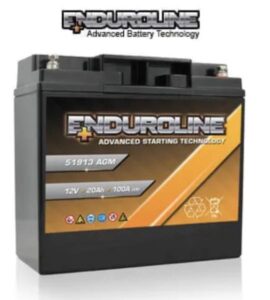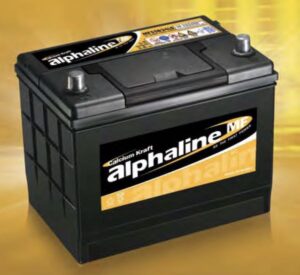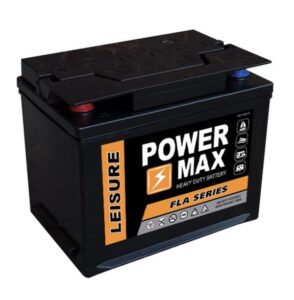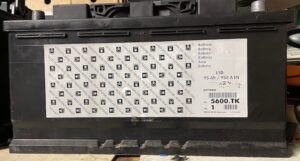I have four old lead acid batteries stored in the garage.
All of these batteries have been retired for some time but I keep them in the garage and charge them up every 3-6 months.
This is the technique I used to measure the capacity of these batteries:-
- Charge the battery fully on my Ctek charger
- Connect a load across the battery designed to take around 25% of the battery over 4-5 hours (based on the C20 capacity of the battery)
- Disconnect the load and leave the battery overnight.
- Measure the open circuit voltage and use this to deduce the state of charge.
- From the state of charge and the known drain, calculate the capacity of the battery.
To be honest, I don’t know if this is a sound method, but it seems logical to me.
The following table from here shows the charge vs o/c voltage from a new AGM battery.
| State of Charge (%) | o/c Voltage | But maybe it’s not so straight forward:- Lead acid comes with different plate compositions that must be considered when measuring SoC by voltage. Calcium, an additive that makes the battery maintenance-free, raises the voltage by 5–8 percent. In addition, heat raises the voltage while cold causes a decrease. Surface charge further fools SoC estimations by showing an elevated voltage immediately after charge; a brief discharge before measurement counteracts the error. Finally, AGM batteries produce a slightly higher voltage than the flooded equivalent. from here The Alphline has a Calcium additive and the Euroline is an AGM battery. |
| 100 | 12.83 | |
| 90 | 12.72 | |
| 80 | 12.6 | |
| 70 | 12.47 | |
| 60 | 12.34 | |
| 50 | 12.2 | |
| 40 | 12.06 | |
| 30 | 11.91 | |
| 20 | 11.76 | |
| 10 | 11.61 |
Using a bit of analysis it looks like 1% reduction in o/c voltage corresponds to a 10% reduction in capacity down to around 30%.
Results
| Battery | L5D | Power Max | Alphaline | Enduroline |
| Type | Flooded | ??? | Calcium | AGM |
| New AH | 95 | 70 | 44 | 20 |
| Age (Years) | 10 | 9 | 10 | 7 |
| C20 Current | 4.75 | 3.5 | 2.2 | 1 |
| Voltage 4 hr after charge | 12.58 | 12.82 | 12.87 | 12.87 |
| Bulb used | 55 | 55 | 24 | 10 |
| Current | 4.6 | 4.6 | 2.0 | 0.8 |
| Hrs | 4 | 4 | 4 | 3.5 |
| AH taken | 18.3 | 18.3 | 8.0 | 2.9 |
| Voltage 24hr after discharge | 12.25 | 12.35 | 12.58 | 10.66 |
| drop in o/c voltage | 2.62% | 3.67% | 2.25% | 17.17% |
| drop in capacity | 26.2% | 36.7% | 22.5% | |
| Estimated present Capacity in AH | 70 | 44 | 34 | 3?? |
| Compared to new | 74% | 63% | 77% | 0% |
The 10 year old L5D starter battery still has 74% of it’s original capacity. It’s cranking capability is is known to be suspect. But that is unimportant as a stand by supply.
The 9 year old PowerMax leisure battery is down to 63%. It was sold as a leisure battery.
The 10 year old Alphaline starter battery is at 77%. (Also mentioned here)
The 7 year old Enduroline motorcycle battery is knackered. I took only 2.9Ah from it and the voltage dropped unacceptably.
Now if we have power cuts, I can use them separately or parallel the three usable batteries (using Schottky diodes to stop circulating currents), and I have 150Ah, or 1.8Kwh to play with.
I have a small inverter 300W inverter so I could power TVs and a few lamps for a few hours
But rather than lug the batteries from the garage into the house, I could put the inverter in the Garage and run an extension lead into the house.
I could even power the gas central heating boiler for a few hours as it only uses 52W.
Conclusions
Old Batteries are a viable source of backup power. They can be maintained by occasional charges, every few months, or by the technique shown here.
Starter motors in cars and vans get replaced when their cranking capability is reduced so that they struggle to start the vehicle. But there may still be plenty of storage capacity left to use as emergency backup in times of power cuts or as a leisure battery. I wish I had done this test before buying my latest leisure battery. I would just have used the L5D starter battery. One lives and learns. The van seemed to struggling a little this winter Maybe I’ll drop a new battery in at the beginning of next winter – the old one will be heading for the garage to join the collection.
One thing is for sure, I will never throw an old starter battery away again – especially in the current energy supply situation.




